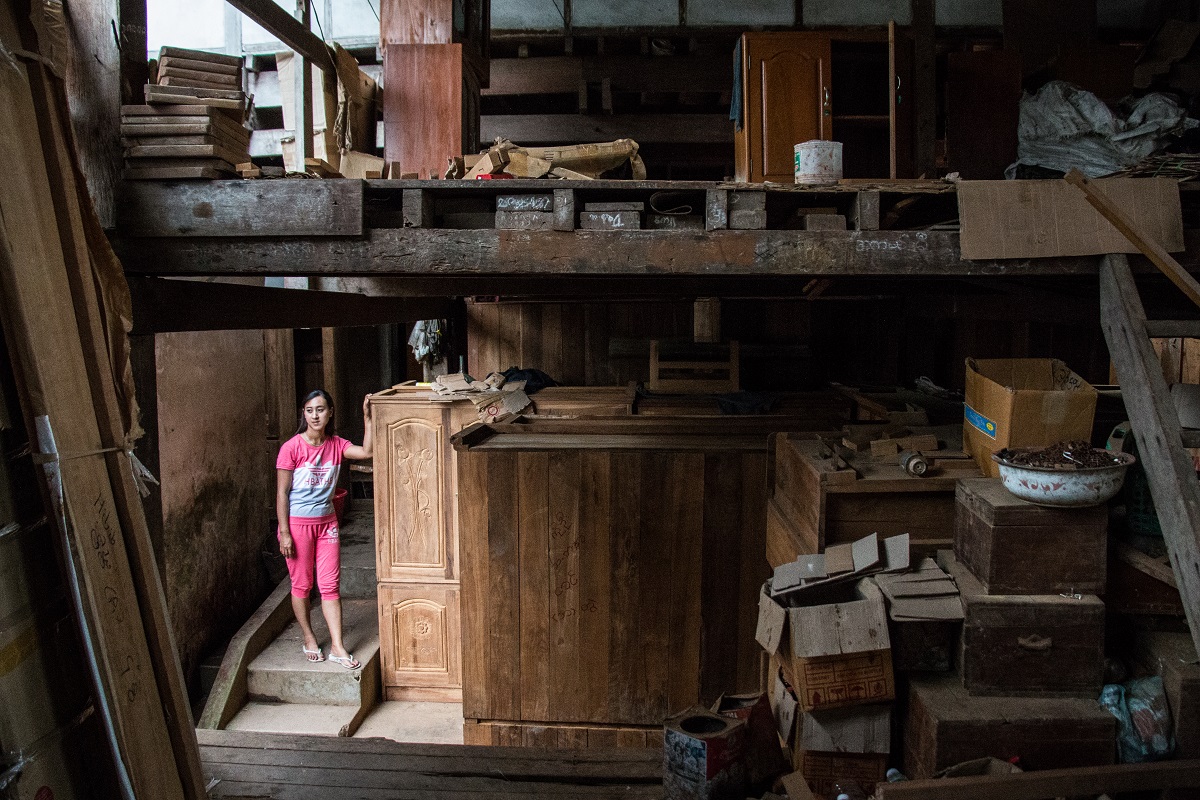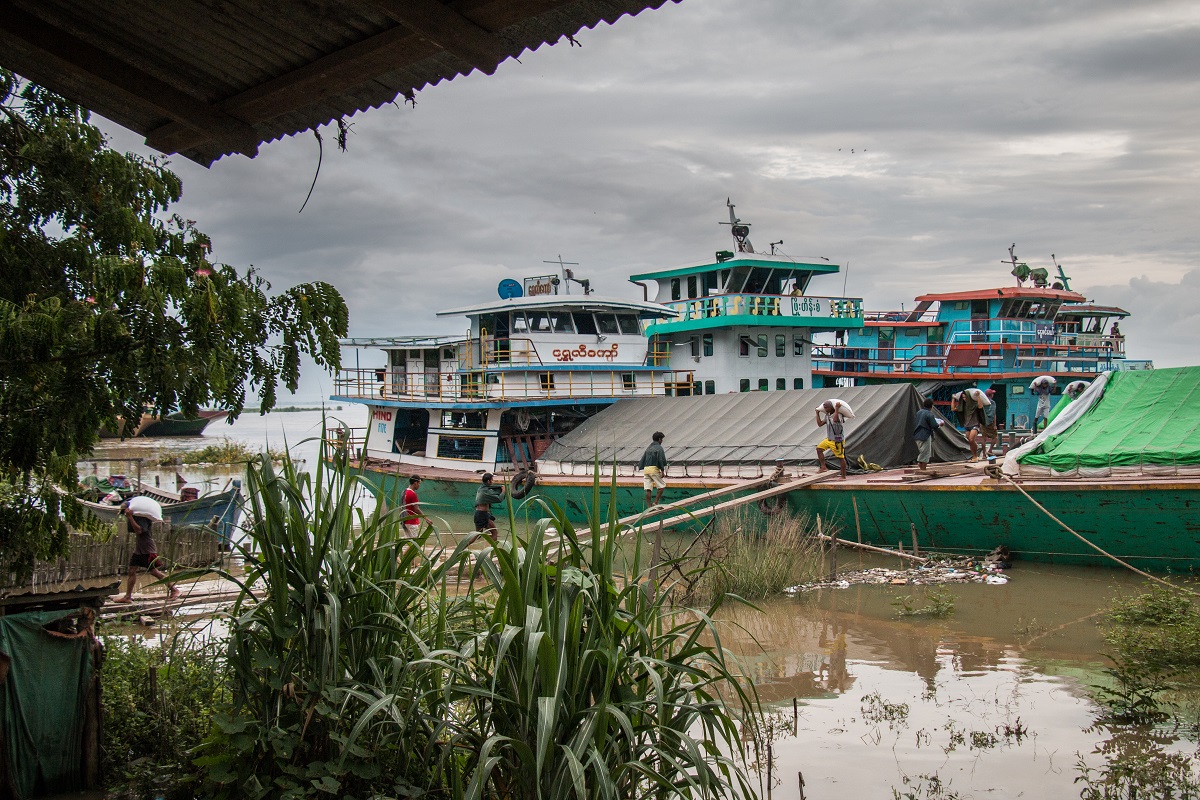- One of many towns of the Myanmar-China border, Bhamo, Myanmar has long been a hub for illegal trade with China, including illegally logged charcoal currently sold.
- Most of the charcoal is bound overland for brisk business with China, yet Bhamo still finds itself without enough money coming in.
- Bhamo has a long history of diversifying its products and services to survive and get ahead.
- This glimpse at Bhamo is part of a series on illegal logging in Myanmar published this week by Mongabay. More reporting, photography, and a short docu-video in this series can be found at Mongabay.com.
BHAMO, Myanmar – Bhamo is a small, busy town set on the bank of the Irrawaddy River in Myanmar’s Kachin state. Its location – at the juncture between the river and China – has made it an essential stop for Myanmar’s bustling illegal charcoal trade, one more commodity to transit through the town.
In one of Bhamo’s busy streets, a furniture store sells wardrobes, displays for Buddha statues and tables. It’s one of the few businesses that cater to local customers, but it has also been affected by Bhamo’s trade.
The shop’s manager, a woman in her 30s – who, her father interjects, has a degree in economics – explains that these days it’s a bit hard to find wood to make furniture. Indeed, Bhamo used to be a hub for the teak trade until a few years ago, and because of the intensive timber export, the source of timber has dried up.

The manager adds that her clients are local people and the shop doesn’t export to China because they don’t have business connections there.
Not far from there, several stories up at the Friendship Hotel in Bhamo, is a typical Chinese-style hotel with a flashing neon sign that welcomes guest in a multitude of languages. In the lobby, the owner explains that his best business was about six years ago – the heydays of logging.
At that time, he says, a ton of rosewood cost up to $515 in Bhamo, and you could sell it on the Chinese side for $22,000, a nice profit even after bribes and transport were deducted. But since 2014, the government cracked down on the illegal export of logs and so business has quieted down.

Turning off the tap of timber wealth has affected most businesses in town.
Despite this, the hotel owner says, he still has paying customers. Most of them are the staff of NGOs who come to work in the camps where people escape the nearby conflicts between the national army and the Kachin Independence Army (KIA). The hotel is several stories high, with a dining hall at the top.
“I want Bhamo to be developed but not like Mandalay and Yangon,” he said, explaining that that the town used to be quiet and now he has to wade through traffic to get to his home, which he does not like.
Bhamo has changed a lot over the years.
It was founded as the capital of an independent Shan State that formed alliances with other kingdoms nearby. From the late 1600s, it was occupied by Burma, and then freed, and conquered again, until officers of the British Empire were posted in the town in 1869.
Forest covered much of the district, and the colonial state used the town as a trading post for timber, with about 110,000 logs exported from the district between 1890-1902 according to colonial records.

By then, it was already a nexus of trade with China, including for smuggled opium. During the Second World War, Bhamo became one of the stops on the Lado/Stilwell Road, built by the Americans to bring supplies from India to assist China in its fight against Japan. Nevertheless, the road never brought the strategic advantage that it had been built for, and it fell into disrepair soon after the end of the war.
Yet Bhamo has maintained its historical position as a trading post to China. The hotel owner explains that when he started the building’s construction in 1993, this was the only tall structure in town and it did not have electricity without a generator.
At that time, the road to China was officially closed because of the war with the KIA, and only the people with the connections to the armed group could use it.

Today, the road is very much open for trade with a busy traffic of corn and charcoal going to China while Myanmar imports electronics and other consumption goods. Those are brought as far as Mandalay, a day’s boat ride downstream.
In the port, just next to the water, a wide shop sells all kinds of electronics and cell phones in elegant white displays. The shop owner started his business ten years ago, but initially they showed movies to a crowd. Now, everyone has DVD players and so they had to adapt.
His daughter explains that their main customers come from the neighboring villages to buy cheap phones. Right now, business is slow. She’s not sure why, “maybe the gold mines didn’t make money.” She adds that in Kachin, there is only logging and mining as good business, and these businesses don’t operate well, so it’s harder.

According to her, the port is busier now than 10 years ago. At that time, they mostly carried gold mining equipment from Mandalay, such as engines, generators, pump and pipes. Today, the boats carry carry corn and rice that will be sold in China. This food trade only picked up three years ago, she says.
Just above the shop in the port’s office, several men mull around a desk. It’s hard to know who works there and who is just enjoying the afternoon shade. One person identifies himself as the port’s official. He explains that there are more and more passenger boats.
In 2011, only 72 boats were registered, he says while looking in a large notebook, then more each year. I ask him about 2015, and he says 150, before writing the number in his notebook next to the others.
As for the exact number of boats transiting through the port, it is hard to know exactly what goods pass through Bhamo. Much of it is not recorded, and perhaps the most valuable products are smuggled, like charcoal and timber or opium before it.
What is clear, however, is that Bhamo’s wealth has been intimately connected to the fluctuations of the trade that passes through it.
Banner image: A temple at nightfall in Bhamo. Photo by Nathan Siegel for Mongabay.
Emmanuel Freudenthal is an investigative reporter whose work has appeared internationally and he can be found on Twitter at @EmmanuelFreuden. Nathan Siegel is a photographer and videographer focusing on international environmental issues. He can be found on Instagram at @npsiegel.
FEEDBACK: Use this form to send a message to the author of this post. If you want to post a public comment, you can do that at the bottom of the page.
